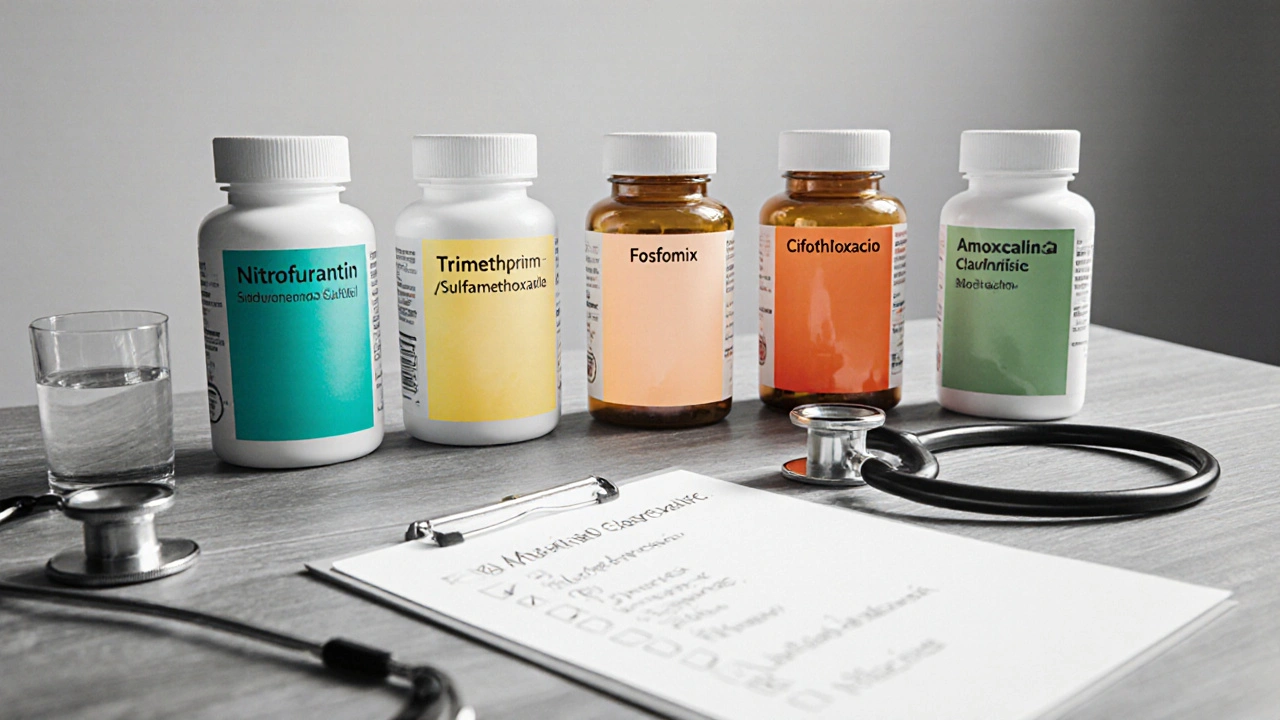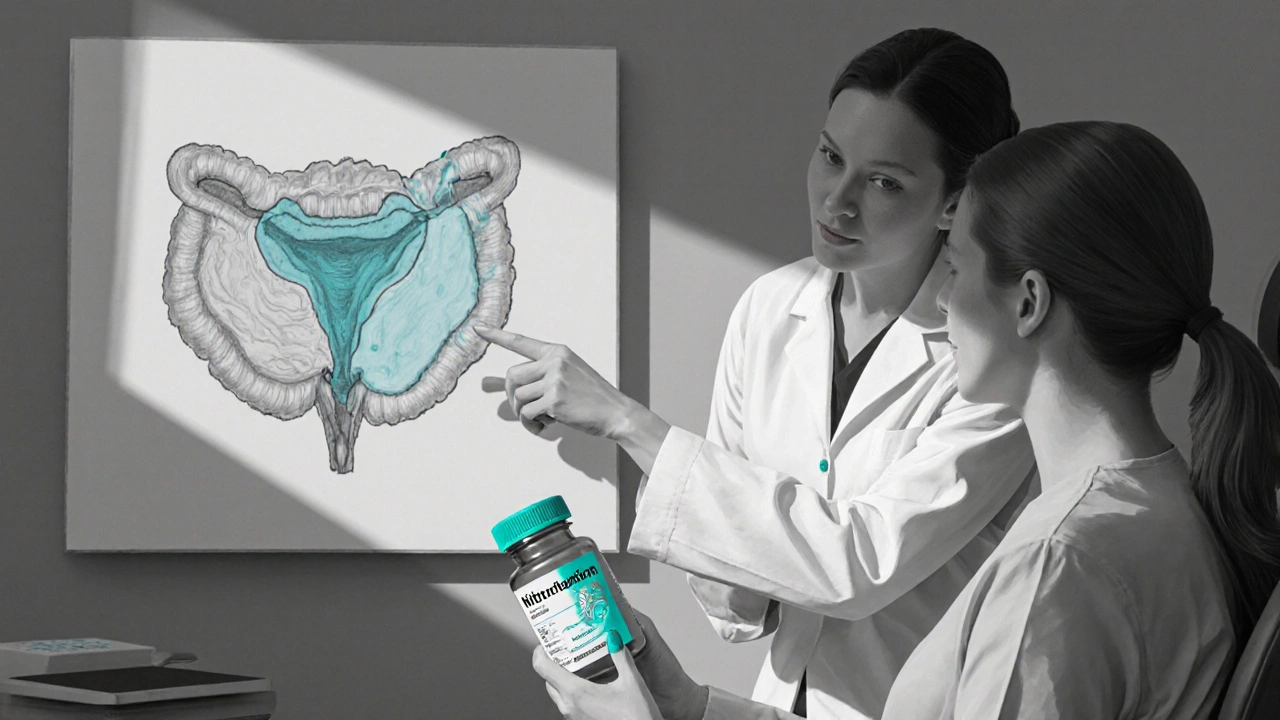UTI Antibiotic Selection Calculator
Select Patient Factors
When a urinary tract infection (UTI) strikes, the first thing most patients think about is the right pill to clear it fast. Nitrofurantoin is a long‑standing oral antibiotic that’s been prescribed for uncomplicated cystitis for decades. But the market now offers several other options, each with its own strengths and drawbacks. This guide walks you through the most common alternatives, breaks down efficacy, safety, and resistance data, and gives you a practical checklist to decide which drug fits your situation.
What Makes Nitrofurantoin Unique?
Nitrofurantoin is a synthetic nitrofuran derivative that works by damaging bacterial DNA after it’s reduced inside the urinary tract. Because it concentrates almost exclusively in the bladder and has limited systemic exposure, it causes fewer gut‑related side effects than many broad‑spectrum agents.
- Typical dose: 100mg twice daily for 5-7days.
- Key indication: Uncomplicated lower urinary tract infection caused by E. coli, Enterococcus faecalis, and some Staphylococcus saprophyticus.
- Renal considerations: Not recommended if creatinine clearance (CrCl) < 60mL/min because urinary concentrations fall below therapeutic levels.
- Common side effects: Nausea, mild headache, and a rare but serious pulmonary reaction with long‑term use.
This profile makes Nitrofurantoin a go‑to for many clinicians, especially when resistance to other agents is a concern.
Top Alternatives to Nitrofurantoin
Below are the five most frequently considered substitutes. Each entry includes the drug’s class, dosing regimen, pros, cons, and typical resistance trends in the United States as of 2025.
| Antibiotic | Class | Typical Dose & Duration | Key Advantages | Major Drawbacks | 2024‑2025 US Resistance Rate* |
|---|---|---|---|---|---|
| Nitrofurantoin | Nitrofuran | 100mg PO BID, 5-7days | High bladder concentration; low systemic impact | Not for impaired renal function; rare pulmonary toxicity | ~4% for E. coli |
| Trimethoprim‑sulfamethoxazole (Bactrim) | Sulfonamide combo | 800/160mg PO BID, 3days | Short course; good oral bioavailability | Higher allergy risk; rising resistance in E. coli | ~15% |
| Fosfomycin | Phosphonic acid derivative | 3g PO single dose | Convenient single dose; works against many MDR strains | Limited data for repeat infections; high cost | ~5% |
| Ciprofloxacin | Fluoroquinolone | 250-500mg PO BID, 3days | Excellent tissue penetration; useful for pyelonephritis | FDA black‑box warnings for tendon rupture, CNS effects; high resistance | ~22% |
| Amoxicillin‑clavulanate | Beta‑lactam/B‑lactamase inhibitor | 500/125mg PO TID, 5-7days | Broad spectrum; covers many beta‑lactamase producers | GI upset; not first‑line for uncomplicated cystitis | ~12% |
*Resistance rates are pooled data from the CDC’s 2024 Antimicrobial Resistance Surveillance Program (ARSP) and reflect community‑acquired isolates of E. coli, the predominant UTI pathogen.
How to Choose the Right Agent: Decision Checklist
- Confirm renal function. If estimated CrCl < 60mL/min, skip Nitrofurantoin and consider Fosfomycin or a low‑dose fluoroquinolone.
- Check allergy history. Sulfa allergy eliminates Trimethoprim‑sulfamethoxazole; fluoroquinolone warnings matter for patients with tendon disorders.
- Evaluate recent antibiotic exposure. Prior use of the same class within the last 30days raises resistance risk.
- Consider pathogen susceptibility. If culture data are available, target the antibiotic with the lowest MIC that reaches therapeutic urinary concentrations.
- Account for convenience. Single‑dose Fosfomycin may improve adherence for patients with busy schedules.
- Factor in cost and insurance coverage. Generic Nitrofurantoin and Trimethoprim‑sulfamethoxazole are usually cheapest; Fosfomycin can be 3‑4× more expensive.
Following this checklist helps you match the drug to the patient’s clinical picture rather than defaulting to habit.

Safety Profile Deep Dive
While all antibiotics carry some risk, the nature of side effects differs markedly.
- Nitrofurantoin: Rare pulmonary fibrosis (incidence <0.1% after >2weeks of therapy). Liver enzyme elevations occur in <1% of users.
- Trimethoprim‑sulfamethoxazole: Stevens‑Johnson syndrome, hemolytic anemia in G6PD‑deficient patients, hyperkalemia due to trimethoprim’s effect on renal tubular secretion.
- Fosfomycin: Diarrhea and mild transient nausea; occasional headache.
- Ciprofloxacin: Tendonitis, QT‑prolongation, potential CNS effects (dizziness, seizures). FDA now recommends reserving fluoroquinolones for conditions where no alternatives exist.
- Amoxicillin‑clavulanate: Biliary colic, high‑grade diarrhea, and risk of Clostridioides difficile infection.
Patients with pre‑existing lung disease should avoid Nitrofurantoin long‑term; those with cardiac arrhythmias need caution with Ciprofloxacin.
Real‑World Prescribing Trends (2023‑2025)
Data from the National Ambulatory Medical Care Survey (NAMCS) show a gradual shift away from fluoroquinolones after the 2019 FDA safety alerts. Nitrofurantoin usage rose from 22% to 31% of first‑line UTI prescriptions between 2022 and 2025. Fosfomycin, once a niche drug, captured about 8% of new scripts, driven by its single‑dose convenience and decent activity against extended‑spectrum beta‑lactamase (ESBL) producers.
Geographically, the Midwest reports the highest Nitrofurantoin resistance (≈6%), while the Pacific Northwest enjoys the lowest (≈3%). These regional nuances underscore the value of local antibiograms.

Frequently Asked Questions
Frequently Asked Questions
Can I take Nitrofurantoin while pregnant?
Nitrofurantoin is generally considered safe in the second and third trimesters. The FDA categorizes it as Pregnancy Category B, but it is avoided near term (≥38weeks) because of a rare risk of hemolytic anemia in the newborn.
What if my urine culture shows a resistant E. coli strain?
If the isolate is resistant to Nitrofurantoin and TMP‑SMX, consider Fosfomycin (single dose) or a tailored dose of a fluoroquinolone if the patient has no contraindications. Always review the susceptibility panel before switching.
Is there a risk of recurrence after using Nitrofurantoin?
Recurrence rates are similar across all first‑line agents when used appropriately-about 15‑20% within 6months. Lifestyle measures (hydration, bladder emptying habits) reduce repeat infections more effectively than choosing one antibiotic over another.
Can older adults safely use Nitrofurantoin?
Yes, provided they have adequate renal function (CrCl ≥60mL/min). In patients with declining kidney function, Fosfomycin or a reduced‑dose TMP‑SMX may be better choices.
Why is Nitrofurantoin not recommended for pyelonephritis?
Because it achieves high concentrations only in the bladder, not in the renal parenchyma. For kidney infections, agents like Ciprofloxacin, Levofloxacin, or an extended‑spectrum beta‑lactam are required.
Bottom Line: Putting It All Together
If you need a reliable, low‑cost first‑line drug for uncomplicated cystitis and your kidneys are working well, Nitrofurantoin remains the top pick. When renal function is impaired, allergies exist, or local resistance spikes, the alternatives-Trimethoprim‑sulfamethoxazole, Fosfomycin, Ciprofloxacin, or Amoxicillin‑clavulanate-provide viable backup options.
Remember: the smartest prescription is the one that matches the patient’s clinical profile, local antibiogram, and personal circumstances. Use the checklist, stay updated on resistance trends, and involve patients in the decision‑making process for the best outcomes.


Written by Guy Boertje
View all posts by: Guy Boertje